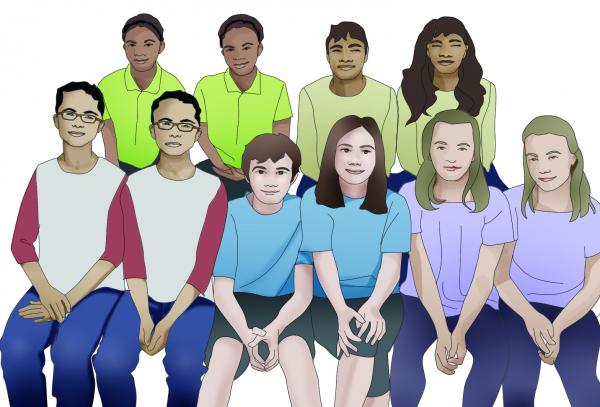Chapter 15. How Would You Know If Schizophrenia is Inherited?
15.1
By:
C. Nathan DeWall, University of Kentucky
David G. Myers, Hope College

15.2
- Chapters
- descriptions off, selected
- captions settings, opens captions settings dialog
- captions off, selected
- English Captions
This is a modal window.
Beginning of dialog window. Escape will cancel and close the window.
End of dialog window.
This is a modal window. This modal can be closed by pressing the Escape key or activating the close button.
This is a modal window.
Note: You will be guided through the Intro, Design, Measure, Interpret, Conclusion, and Quiz sections of this activity. You can see your progress highlighted in the non-clickable, navigational list at the right.
Watch this video from your author, Nathan DeWall, for a helpful, very brief overview of the activity.
15.3

So, how would you know if schizophrenia is inherited? To study this question effectively in your role as researcher, you need to DESIGN an appropriate study that will lead to meaningful results, MEASURE rates of schizophrenia, and INTERPRET the larger meaning of your results, considering how your findings would apply to the population as a whole.
We will start by choosing a good research DESIGN. Of the options below, which one would be best for finding out if schizophrenia is inherited?
| A. |
| B. |
| C. |
Click on "Video Hint" below to see brief animations describing Twin Studies, Case Studies and Experiments.
Video Hint
15.4
Twin Studies:
- Chapters
- descriptions off, selected
- captions settings, opens captions settings dialog
- captions off, selected
- English Captions
This is a modal window.
Beginning of dialog window. Escape will cancel and close the window.
End of dialog window.
This is a modal window. This modal can be closed by pressing the Escape key or activating the close button.
This is a modal window.
Case Studies:
- Chapters
- descriptions off, selected
- captions settings, opens captions settings dialog
- captions off, selected
- English Captions
This is a modal window.
Beginning of dialog window. Escape will cancel and close the window.
End of dialog window.
This is a modal window. This modal can be closed by pressing the Escape key or activating the close button.
This is a modal window.
Experiments:
- Chapters
- descriptions off, selected
- captions settings, opens captions settings dialog
- captions off, selected
- English Captions
This is a modal window.
Beginning of dialog window. Escape will cancel and close the window.
End of dialog window.
This is a modal window. This modal can be closed by pressing the Escape key or activating the close button.
This is a modal window.
15.5

You have chosen a Case Study design. With a Case Study design, you will choose one person or a small group of people, such as identical twins, who share a fetal environment and are genetically identical, or fraternal twins, who share a fetal environment but are genetically no more similar than ordinary brothers and sisters.
Of the following choices, which one represents the best participants for your study?
| A. |
| B. |
| C. |
| D. |
15.6

What could we learn from these participant choices?
A small group of people who eat at restaurants every night. This option does not tell you about your participants’ weight or the size of the dinner plates they use. To know whether using larger dinner plates make us fat, you would need to study a group of individuals who have average body weight. This way you can determine whether changing the size of the plates they use causes them to behave in ways that will increase their weight.
A small group of people who are obese. This option tells you about your participants’ weight but not about the size of the dinner plates they use. To know whether using larger dinner plates makes us fat, you would need to study a group of individuals who have average body weight (not just people who are obese), and then vary the size of the dinner plates they use to see if that causes them to increase their weight.
A small group of people who are thin. This option tells you about your participants’ weight but not about the size of the dinner plates they use. To know whether using larger dinner plates makes us fat, you would need to study a group of individuals who have average body weight (not just people who are thin), and then vary the size of the dinner plates they use to see if that causes them to increase their weight.
A small group of people who have average body weight. You were right to choose people who have average body weight, but this option doesn’t tell us about the size of the dinner plates they use. To know whether using larger dinner plates makes us fat, you would need to study a group of individuals who have average body weight, and then vary the size of the dinner plates they use to see if that causes them to increase their weight. Also, you would need to study a large group, not a small group as in this Case Study approach, in order to determine whether the idea of using larger dinner plates making us fat may apply to the larger population.
Trying to choose a sample of participants helps us realize that the CASE STUDY IS NOT THE BEST RESEARCH DESIGN to test this question. We’d get more helpful results by studying large groups of identical and fraternal twins who do and do not have a diagnosis of schizophrenia. This would help us determine whether schizophrenia is inherited.
Click “Next” to go back and try again to select the most effective research design.
15.7

You have chosen an Experimental design, which means you need to set up an experimental group and a control group. For example, suppose researchers are interested in knowing whether exposure to spiders, compared with puppies, increases anxiety. The researchers would expose some participants to spiders and others to puppies. Next, they would measure all participants’ anxiety levels. This would enable the researchers to determine whether participants who were exposed to the spiders reported the highest levels of anxiety. (They would. Spiders scare people more than puppies do!)
Describe below how you would set up your experiment to determine whether schizophrenia is inherited:
15.8

To use the Experimental design to test whether schizophrenia is inherited, we would need to have an experimental group of pairs randomly assigned to be same-aged and genetically identical (as identical twins are) and compare them to pairs randomly assigned to be same-aged and genetically similar (as fraternal twins are). We would then determine whether the genetically-identical pairs are more likely than the genetically-similar pairs to develop a shared schizophrenia diagnosis. But wait! It is not possible to make such assignments—you can’t randomly assign people to be an identical or fraternal twin.
So, EXPERIMENTAL IS NOT THE BEST RESEARCH DESIGN for this study.
For more on Research Ethics and why we can’t always use an experimental design in psychology research, click “Video Hint” below.
Video Hint
Click “Next” to go back and try again to select the most effective research design.
15.9
Research Ethics:
- Chapters
- descriptions off, selected
- captions settings, opens captions settings dialog
- captions off, selected
- English Captions
This is a modal window.
Beginning of dialog window. Escape will cancel and close the window.
End of dialog window.
This is a modal window. This modal can be closed by pressing the Escape key or activating the close button.
This is a modal window.
15.10

Nice work! You have correctly chosen to use a Twin Study Design.
Next, you need to choose the most appropriate study participants.
Of the following options, which one represents the best group for your study?
| A. |
| B. |
| C. |
| D. |
15.11

You chose Two groups—of identical and fraternal twins; all of these individuals have a diagnosis of schizophrenia., but this is NOT CORRECT.
This is not the best option, because all your participants have a diagnosis of schizophrenia. To know whether schizophrenia is inherited, you would need to study identical and fraternal twins who do and do not have a diagnosis of schizophrenia.
Click “Next” to try again to choose the most appropriate study participants.
15.12

You chose A group of identical twins who have a diagnosis of schizophrenia, but this is NOT CORRECT.
This is not the best option for two reasons. The first is that all participants have a diagnosis of schizophrenia. The second is that all participants are identical twins. To know whether schizophrenia is inherited, you would need to study identical and fraternal twins who do and do not have a diagnosis of schizophrenia.
Click “Next” to try again to choose the most appropriate study participants.
15.13

You chose A group of fraternal twins who have a diagnosis of schizophrenia, but this is NOT CORRECT.
This is not the best option for two reasons. The first is that all participants have a diagnosis of schizophrenia. The second is that all participants are fraternal twins. To know whether schizophrenia is inherited, you would need to study identical and fraternal twins who do and do not have a diagnosis of schizophrenia.
Click “Next” to try again to choose the most appropriate study participants.
15.14

Good job! You have correctly chosen to use a Twin Study design. You also chose an appropriate sample of participants, with Two groups—of identical and fraternal twins; some of these individuals have a diagnosis of schizophrenia, and some of them do not have a diagnosis of schizophrenia. Now you need to determine how best to MEASURE the relevant behavior or mental process, which in this case is rates of schizophrenia.
Of the following options, which one would be the best way to measure rates of schizophrenia?
| A. |
| B. |
| C. |
| D. |
15.15

You chose Have participants complete an interview with a friend who has an interest in psychology to determine whether their friend thinks they have a diagnosis of schizophrenia, but this is NOT CORRECT.
This would not be the best option, because you do not know whether the friend is qualified to make a diagnosis of schizophrenia. It is also not ethical to have a person try to be their friend’s psychologist. To know whether schizophrenia is inherited, we have to know whether participants receive a diagnosis from a licensed psychologist who uses established criteria.
Click “Next” to try again to select the best way to measure rates of schizophrenia in your participants.
15.16

You chose Have participants report whether a licensed psychologist has completed a structured clinical interview and diagnosed a close family member with schizophrenia, but this is NOT CORRECT.
This option would tell you whether a close family member had been diagnosed with schizophrenia, but that is not the same thing as knowing whether participants actually have a diagnosis of schizophrenia themselves. To know whether schizophrenia is inherited, we have to know whether participants receive a diagnosis from a licensed psychologist who uses established criteria.
Click “Next” to try again to select the best way to measure rates of schizophrenia in your participants.
15.17

You chose Have participants complete a questionnaire that measures their attitudes toward licensed psychologists who conduct structured clinical interviews to determine whether people meet established criteria for a diagnosis of schizophrenia, but this is NOT CORRECT.
This option only offers information about participants’ attitudes toward those who diagnose schizophrenia but does not tell you whether your participants actually have a diagnosis of schizophrenia. To know whether schizophrenia is inherited, we have to know whether participants actually receive a diagnosis from a licensed psychologist who uses established criteria.
Click “Next” to try again to select the best way to measure rates of schizophrenia in your participants.
15.18
Nice job! You have correctly chosen to use a Twin Study design. You chose an appropriate sample of participants, with two groups—of identical and fraternal twins; some of these individuals have a diagnosis of schizophrenia, and some of them do not have a diagnosis of schizophrenia. You also chose how best to MEASURE the relevant behavior or mental process, which in this case is rates of schizophrenia. You selected the option, Have participants complete a structured clinical interview with a licensed psychologist who is able to determine whether they meet established criteria for a diagnosis of schizophrenia.
Several studies have tested the hypothesis that schizophrenia is inherited. They have used twin studies like yours to estimate the heritability of schizophrenia—the extent to which variation among individuals can be attributed to their differing genes. Across numerous studies, schizophrenia does in fact show a genetic effect (Gottesman, 2001). The co-twin of a fraternal twin with schizophrenia has about a 1 in 10 chance of sharing the diagnosis. For identical twins, that chance goes up to 1 in 2, even when the twins are raised apart (Plomin et al., 1997)! So, we have some clear evidence that schizophrenia is indeed inherited.
Knowing this, you need to consider how you can apply what you’ve learned to the larger population—beyond the people you’ve studied. Consider where you might encounter roadblocks to confidence in your results. What factors might keep you from being able to apply what you’ve learned in a broader context?
15.19

You tested whether schizophrenia is inherited. You had participants complete a structured clinical interview with a licensed psychologist, who could determine whether participants met established criteria for a diagnosis of schizophrenia. The likelihood of having a diagnosis of schizophrenia was then compared between fraternal twins and identical twins. Several factors may influence your study results, and they might not have any relation to whether your participants are fraternal or identical twins! Factors that could interfere with our INTERPRETATION of results are called confounding variables.
From the factors listed below, select those that could affect your confidence about whether schizophrenia is inherited:
| Number of books participants read about people who have schizophrenia | |
| Month in which participants were born | |
| Whether participant’s mother had the flu during her pregnancy | |
| Number of unrelated friends who have a diagnosis of schizophrenia | |
| Whether family members ever thought participants behaved as if they had a diagnosis of schizophrenia |
Click on "Video Hint" below to see a brief animation describing Confounding Variables.
Video Hint
15.20
Confounding Variables:
- Chapters
- descriptions off, selected
- captions settings, opens captions settings dialog
- captions off, selected
- English Captions
This is a modal window.
Beginning of dialog window. Escape will cancel and close the window.
End of dialog window.
This is a modal window. This modal can be closed by pressing the Escape key or activating the close button.
This is a modal window.
15.21

The confounding variables for your study would include those highlighted below:
| Number of books participants read about people who have schizophrenia | |
| Month in which participants were born | |
| Whether participant’s mother had the flu during her pregnancy | |
| Number of unrelated friends who have a diagnosis of schizophrenia | |
| Whether family members ever thought participants behaved as if they had a diagnosis of schizophrenia |
To have the most confidence in your results, you need to keep track of the highlighted confounding variables. Schizophrenia is heritable, but there are also environmental factors that can increase the likelihood of a diagnosis. Exposure to viral infections prenatally, for example, is thought to impair brain development and thus increase a baby’s likelihood of developing schizophrenia later. Therefore, those born after the fall-winter flu season, and those known to have been exposed to the flu prenatally are both at increased risk.
Unless you keep track of the highlighted confounding variables, you might draw incorrect conclusions about your study results.
15.22
- Chapters
- descriptions off, selected
- captions settings, opens captions settings dialog
- captions off, selected
- English Captions
This is a modal window.
Beginning of dialog window. Escape will cancel and close the window.
End of dialog window.
This is a modal window. This modal can be closed by pressing the Escape key or activating the close button.
This is a modal window.
You may do better on the Quiz if you take notes while watching this video. Feel free to pause the video or re-watch it as often as you like.
REFERENCES
Bienvenu, O. J., Davydow, D. S., & Kendler, K. S. (2011). Psychiatric ‘diseases’ versus behavioral disorders and degree of genetic influence. Psychological Medicine, 41, 33–40.
Gottesman, I. I. (2001). Psychopathology through a life span—genetic prism. American Psychologist, 56, 867-881.
Plomin, R., DeFries, J. C., McClearn, G. E., & Rutter, M. (1997). Behavioral genetics. New York: Freeman.
Xu, B., Ionita-Laza, I., Roos, J. L., Boone, B., Woodrick, S., Sun, S., Levy, S., ... Karayiorgou, M. De novo gene mutations highlight patterns of genetic and neural complexity in schizophrenia. Nature Genetics, 44, 1365–1369.
15.23
QUIZ: NOW WHAT DO YOU KNOW?
1. You chose to measure schizophrenia rates by having a licensed psychologist conduct a structured clinical interview. Why?
| A. |
| B. |
| C. |
| D. |
2. To study whether schizophrenia is inherited, why did you choose NOT to use a Case Study design?
| A. |
| B. |
| C. |
| D. |
3. When considering confounding variables, you included whether a participant’s mother had the flu during pregnancy. Why did you make that choice?
| A. |
| B. |
| C. |
| D. |
4. Robert’s fraternal twin sister Desiree has a diagnosis of schizophrenia. Armend’s identical twin brother, Nigel, also has a diagnosis of schizophrenia. Robert, compared with Armend, probably has a ______ chance of having a diagnosis of schizophrenia.
| A. |
| B. |
| C. |
| D. |
5. If someone asks you whether schizophrenia is inherited, how might you respond based on what you learned in this activity?